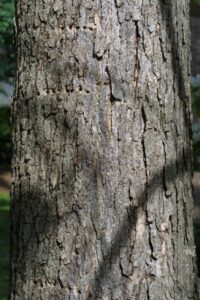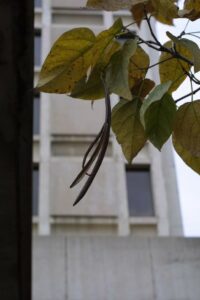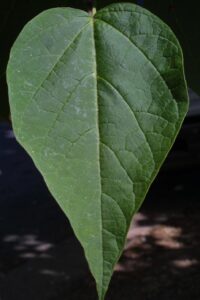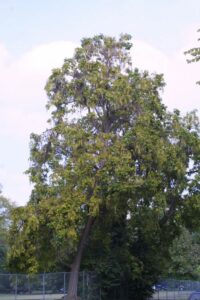Botanical Name:
Catalpa speciosa
Family Name:
Bignoniaceae
Description:
Northern catalpa is a short-lived, medium to large deciduous tree that can have a rounded, symmetrical crown, but weak wood and branch structure often result in a less desirable shape. It is easily recognized by its erect panicles of large, white flowers, its large (up to 12’’ long) heart-shaped leaves, and its long, straight seed pods that remain on the branches through the winter.
Size:
40-70’ tall; 20-50’ spread
Habitat and Range:
The original range of northern catalpa did not extend to northern Indiana. It was native to a narrow zone in western Tennessee through southern Indiana and Illinois to parts of Arkansas and Missouri, but its current range is larger due to planting by humans. Catalpa is most abundant in sunny areas along streams, rivers, or lakes. In South Bend, catalpa trees are easily spotted along the St. Joseph River when they are flowering in early summer.
Attributes:
Northern catalpas put on one of the most spectacular early summer flower shows of all our native trees. The panicles of broadly tubular white flowers are produced in great abundance. Each flower is about 1.5’’ across and 2” long with purple spotting and bright yellow stripes on the lower petal lip. The large, cordate leaves have long tapering tips and soft hairy undersides. Drawbacks include an abundance of ground litter from the large leaves, the long seed pods, and broken twigs and branches.
Wildlife Value:
Bumblebees, carpenter bees, honeybees, and some moths visit the flowers in search of nectar. In older trees, cavities in the trunk or branches are occupied by squirrels, Screech Owls, and some other cavity-nesting birds.
Did you know?
• Northern catalpa has some interesting nicknames. One of these, cigar tree, derives from the shape of the seedpods, which are in fact much longer than any cigar. A second nickname, bait tree, comes from the catalpa moth caterpillar (Ceratomia catalpae). These insects can severely harm catalpa trees when in great abundance, but they are also prized by some anglers as live bait for catching bluegills, largemouth bass, and catfish.
Benefits to Our Community (based on carbon dioxide sequestered, storm water runoff avoided, and air pollution removed each year):
Over the next 15 years, this tree will give back $90 worth of benefits to our community.





